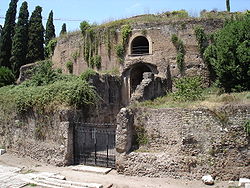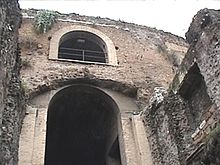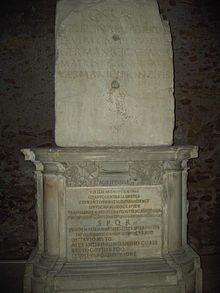- Mausoleum of Augustus
-
Mausoleum of Augustus
Mausoleum of AugustusLocation Campus Martius Built in 28 BC Built by/for Augustus Type of structure Mausoleum Related articles None. Cinerary urn of Agrippina which now rests in the Palazzo dei Conservatori of the Capitoline Museums near the tabularium.
The Mausoleum of Augustus (Italian: Mausoleo di Augusto) is a large tomb built by the Roman Emperor Augustus in 28 BC on the Campus Martius in Rome, Italy. The Mausoleum, now located on the Piazza Augusto Imperatore, is no longer open to tourists, and the ravages of time and carelessness have stripped the ruins bare. However, the ruins remain a dominating landmark on the northern side of the Campus Martius.
The Mausoleum was one of the first projects initiated by Augustus in the city of Rome following his victory at the Battle of Actium in 31 BC. The mausoleum was circular in plan, consisting of several concentric rings of earth and brick, planted with cypresses and capped (possibly, as reconstructions are unsure at best) by a conical roof and a statue of Augustus. Vaults held up the roof and opened up the burial spaces below. Twin pink granite obelisks flanked the arched entryway; these now stand, one at the Piazza dell'Esquilino (on the northwest side of the Basilica of Santa Maria Maggiore) and other at the Quirinal fountain. The completed Mausoleum measured 90 m (295 ft) in diameter by 42 m (137 ft) in height.
A corridor ran from the entryway into the heart of the Mausoleum, where there was a chamber with three niches to hold the golden urns enshrining the ashes of the Imperial Family. Remains buried inside the Mausoleum before Augustus include those of Marcus Claudius Marcellus (who was the first to be buried there, in 23 BC), Marcus Agrippa in 12 BC, Nero Claudius Drusus in 9 BC, Octavia Minor (the sister of Augustus) in 9 or 11 BC, Gaius and Lucius, grandsons and heirs of Augustus. After the emperor himself, the Mausoleum hosted the ashes of Livia (Augustus' wife), Germanicus, Agrippina the Elder, Agrippina's daughter Julia Livilla, Nero (son of Germanicus), Drusus Caesar (son of Germanicus), Caligula, Tiberius, Drusus Julius Caesar (son of Tiberius), Nero Claudius Drusus and Antonia Minor (parents of Claudius), Claudius, Britannicus (the son of Claudius), the embalmed body of Poppaea Sabina wife of Nero, Julia Domna (later moved to Mausoleum of Hadrian), and Nerva, the last emperor for whom the mausoleum was opened.
In 410, during the sack of Rome by Alaric, the pillaging Visigoths rifled the vaults, stole the urns and scattered the ashes, without damaging the structure of the building (Lanciani). In the Middle Ages the artificial tumulus was fortified as a castle— as was the mausoleum of Hadrian, turned into the Castel Sant'Angelo— and occupied by the Colonna family. After the disastrous defeat of the Commune of Rome at the hands of the Count of Tusculum in 1167, the Colonna were disgraced and banished, and their fortification in the Campo was dismantled. Thus it became a ruin.
In the 19th century, the ruins were used for bullfights, and later as a concert hall (Young). It was not until the 1930s that the site was opened as a preserved archaeological landmark along with the newly moved and reconstructed Ara Pacis nearby. The restoration of the Mausoleum of Augustus to a place of prominence featured in Benito Mussolini's ambitious reordering of the city of Rome which strove to connect the aspirations of Italian Fascism with the former glories of the Roman Empire. Mussolini viewed himself especially connected to the achievements of Augustus, seeing himself as a 'reborn Augustus' ready to usher in a new age of Italian dominance.
See also
References
- Dal Maso, Leonardo B., Rome of the Caesars. Bonechi: Florence, 1974.
- Lanciani, Rodolpho.Pagan and Christian Rome, 1892. On-line
- Young, Norwood., P. Barrera (rev.). Rome and Its Story. J.M. Dent & Sons Ltd: London, 1951 (original edition, 1901).
External links
Coordinates: 41°54′22″N 12°28′35″E / 41.90611°N 12.47639°E
Categories:- Buildings and structures completed in the 1st century BC
- Roman emperors' mausoleums
- Augustan building projects
- Ancient Roman buildings and structures in Rome
Wikimedia Foundation. 2010.



